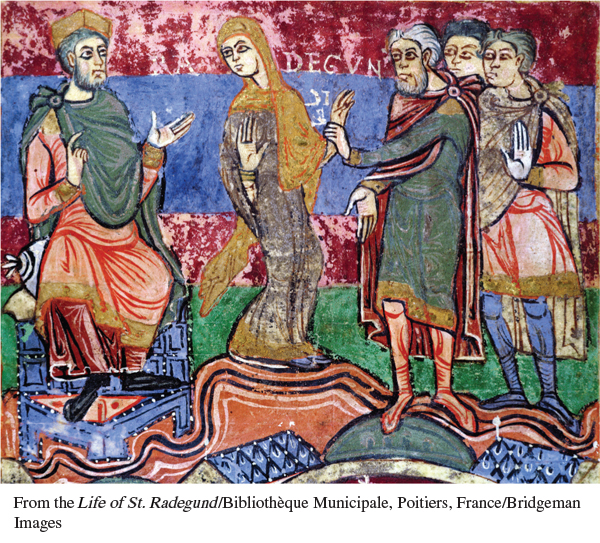The Merovingians
Clovis established the Merovingian dynasty in about 481 (see Chapter 7), and under him the Frankish kingdom included much of what is now France and a large section of southwestern Germany. Following Frankish traditions in which property was divided among male heirs, at Clovis’s death the kingdom was divided among his four sons. Historians have long described Merovingian Gaul in the sixth and seventh centuries as wracked by civil wars, chronic violence, and political instability as Clovis’s descendants fought among themselves. So brutal and destructive were these wars and so violent the conditions of daily life that the term Dark Ages was at one time used to designate the entire Merovingian period, although more recently historians have noted that the Merovingians also created new political institutions, so the era was not uniformly bleak.
Merovingian rulers also developed diverse sources of income. These included revenues from the royal estates and the “gifts” of subject peoples, such as plunder and tribute paid by peoples east of the Rhine River. New lands might be conquered and confiscated, and served to replace lands donated as monastic or religious endowments. All free landowners paid a land tax, although some landowners gradually gained immunity from doing so. Fines imposed for criminal offenses and tolls and customs duties on roads, bridges, and waterways (and the goods transported over them) also yielded income. As with the Romans, the minting of coins was a royal monopoly, with drastic penalties for counterfeiting.
The Franks also based some aspects of their government on Roman principles. For example, the basis of the administrative system in the Frankish kingdom was the civitas (SIH-
229
Within the royal household, Merovingian politics provided women with opportunities, and some queens not only influenced but occasionally also dominated events. Because the finances of the kingdom were merged with those of the royal family, queens often had control of the royal treasury just as more ordinary women controlled household expenditures. The status of a princess or queen also rested on her diplomatic importance, with her marriage sealing or her divorce breaking an alliance with a foreign kingdom or powerful noble family; on her personal relationship with her husband and her ability to give him sons and heirs; and on her role as the mother and guardian of princes who had not reached legal adulthood.

Queen Brunhilda (543?–613), for example, married first one Frankish king and at his death another. When her second husband died, Brunhilda overcame the objections of the nobles and became regent, ruling on behalf of her son until he came of age. Later she governed as regent for her grandsons and, when she was nearly seventy, for her great-
Merovingian rulers and their successors led peripatetic lives, traveling constantly to check up on local administrators and peoples. Merovingian kings also relied on the comites and bishops to gather and send local information to them. The court or household of Merovingian kings included scribes who kept records, legal officials who advised the king on matters of law, and treasury agents responsible for aspects of royal finance. These officials could all read and write Latin. Over them all presided the mayor of the palace, the most important secular figure after the king, who governed the palace and the kingdom in the king’s absence. Mayors were usually from one of the great aristocratic families, which increasingly through intermarriage blended Frankish and Roman elites. These families possessed landed wealth — villas over which they exercised lordship, dispensing local customary, not royal, law — and they often had rich and lavish lifestyles.